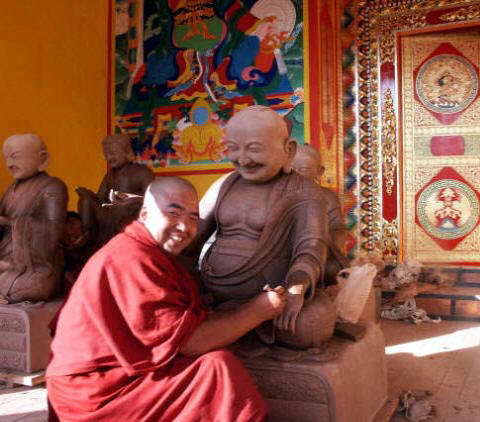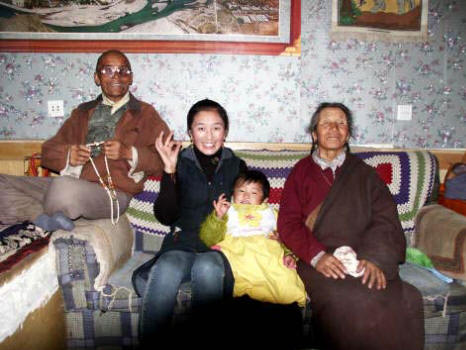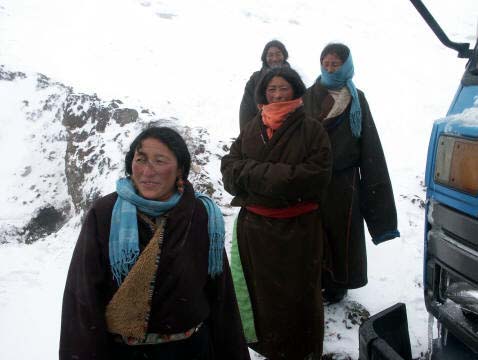Star Date: January 2006
China: Gansu and Sichuan
Hello Dear Family & Friends!
Tashi Delek!
(Hello – Tibetan)
“It is not the goal but the way there that matters, and the harder the way the more worthwhile the journey.”
(Wilfred Thesiger – British Explorer- “Arabian Sands”)

Tibetan pilgrim offering juniper

Monks come in all shapes and sizes.
Joy or Pain? Is the hard way really the most rewarding? Many spiritual paths suggest that we can choose our method of learning life’s lessons. Why not choose joy? As we headed south from Dunhuong to Xining and on to Xiahe the pain of the difficult journey was rewarded with the great joy of discovery. Straight up towards the Tibetan Plateau we quickly left any warm rays of autumn behind. The roads were long, windy, and treacherous at times. Our first stop was Tongren. The lively frontier town market was full of a mixture of Tibetans and Muslim Tus (distant cousins of the Mongols) and we knew we were headed in the right direction. This place, which is completely out of the tourist loop, held a secret jewel at the Wutun Si Monastery. We took a taxi to the upper monastery and as we were exploring the small dirt alleyways we met a monk returning home from shopping. He invited us to his room for tea. The water was heated on a passive solar coil in the center of a 4 ft satellite dish type contraption, covered with little mirrors for attracting the sun. Wutun Si Monastery is home to the main artists for all of the Tibetan Buddhist world. They even supply many thangkas, or intricate paintings, of all sizes for the main Potala Palace in Lhasa, Tibet. These thangkas, which take months or years to paint, usually sell for hundreds of dollars but we could have purchased them from Delajia or in the Upper Monastery’s little art shop for as little as $10. We usually don’t buy anything because “if you buy it you carry it.” Instead we promised to pass along their information in case you are ever interested. (see below)

A twinkling artist at Tongren who knows his subject well!
The monastery was an authentic working monastery with happy artists busily painting or carving and the rest of the monks engrossed in a puja prayer ceremony. They invited us into the dark main temple to observe as they donned robes, wigs, and hats and chanted in deep tones while clanging cymbals and blowing copper horns. They proudly told us that their statues are painted with extra care and detail and after seeing many temples we had to agree. We spent a pleasant sunny afternoon in this beehive of activity and we felt really welcome, especially after being invited to eat with them. The massive vats full of noodles and chunks of yak and the urns of butter tea were emptied into the awaiting bowls. We politely declined having “just eaten”!
We met our first westerner in ages down the hall from us in Tongren. Ian, a 35 year old Brit living in Thailand, came to China 15 years ago and fell in love with it. Since then he has ridden his bike around for 2 months, Spring and Fall, with over 15 visits to date. As we took the bus the next morning over the snowy, muddy pass towards Xiahe we figured out that he must have been even crazier than us. (or a fakir – an Indian holy man whose self-inflicted pain allows for ‘greater enlightenment’). Our bus ride was a lively affair, packed with Tibetans, oversized bags and an occasional chicken. Passing through the high grasslands past herds of yaks and lonely villages we arrived at the bus station in the Chinese part of town. Walking past new hotels and buildings made of white tiles and blue tinted windows we strolled up the street towards Labrang Monastery and the Tibetan part of town.

A Tibetan family in the market.
“Oh Mani Padmi Hum”. “Oh Mani Padmi Hum”. (Mantra – the jewel of the lotus). This chant of the Tibetan pilgrims echoed through the narrow alleyways as they circumambulated the monastery (always clockwise) spinning ornate hand prayer wheels, clutching prayer beads, or turning the hundreds of 3ft to 10 ft high wooden prayer wheels along the 4 km route. Some were completely focused, some prostrated themselves along the ground for hundreds of miles, others chatted merrily as they gave each wheel a good spin, and we even saw one man talking on his cell phone while ‘praying’. Who knows, maybe he had God on the other end?
We walked with pilgrims of all shapes and sizes . Losing ourselves in this eclectic collection was a remarkable experience. These devout Buddhists, who have very few worldly possessions are full of child-like curiosity and fun. Spending a good part of their day silently repeating their mantras and staying connected to the ‘Source’ these joyful folk often just ‘twinkle’. Always ready to make fun of life we shared many a hearty laugh together.

Lively Buddhist puja at Wutun Si Monastery
This is an important pilgrimage site for Tibetans and it seemed that for some of the nomads this may have been one of their first trips into town. When 2 scruffy looking women stuck their tongues out at me I knew this was the case, as they still believe that demons can shape shift and hide everything but their green forked tongues. Knowing what to do I simply stuck my tongue back at them and my pink tongue cleared my reputation on the spot. This forgotten, out of the way area has been overlooked and in many ways it is more authentic than politically torn Tibet itself.
Labrang Monastery is the largest Tibetan Monastery outside of Lhasa. Formerly home to 4800 monks and currently 1200, it is easy to get lost within this maze of little alleys, temples and courtyards. The stark contrast of brilliant blue sky, maroon and white temples punctuated with fuchsia and saffron robes of the monks and Tibetan pilgrims in their best chupas and jewelry, is a sight etched in our minds. Exploring one of the side streets we greeted an old woman with a cheery, “Tashi Delek”. Before we knew what happened this Tibetan family had invited us into their home and into their hearts! We gladly accepted cups of hot tea around the glowing stove. Several family members and neighbors appeared and disappeared.

Determined pilgrim in Xiahe.
It’s not often foreigners even wander into this neighborhood let alone visit in the living room. The niece and her baby arrived and with the help of several inadequate Tibetan/English schoolbooks we got to know each other a little bit. Two of their children had escaped to Daramsala in northern India and had sent photos to say they were ok. They saw our camera and asked if we could take a picture and mail it to them.
Invited to return at 5pm the next afternoon we arrived with fresh popcorn, hot buns, and gifts. The weather had changed suddenly and we avoided the bitter cold wind and warmed ourselves with their kindness and more hot tea and goodies. Hawaii seemed a million miles away as we showed them photos of family, friends and life back home. We played games and they all sat spellbound as I read them a story about the Yeti from their English textbook. Amid great laughter, with cameras blazing, we took several photos and a few weeks later returned the copies in the old brown envelope provided. In the days of instant throw away cameras we forget that a family may have never had a photo taken. On our way home the dirt road was suddenly full of sand, with a dozen young girls shoveling madly. We stopped to talk to them and Joseph took a group photo. They became absolutely hysterical with laughter when they looked at themselves in the viewfinder. One girl even threw herself into the sand and roared with amusement. We had tears running down our faces just watching them.

Tibetans circumambulating Labrang Monastery.
After a trip to a local shop for long johns and wool socks we ventured out to find the Mosque hidden on the side of the hill. Relaxed and friendly the Tus Muslims in the courtyard made the offer for us to climb up the minaret – a rare opportunity. The view was spectacular but what caught our eye was the blending of cultures and tolerance of religions. Atop this Islamic tower we saw two Tibetan Buddhists prostrating and chanting while the ever ready Chinese firecrackers exploded, scaring away the demons. This small town of Xiahe should not be missed.
Braving the cold we wished we had arrived earlier in the season. The problem with the current cold snap was that there is no central heating. You wake up under 2 tons of heavy felt quilts and you can see your breath in your room, it’s freezing outside and just as cold inside every building. Two thin blooded Hawaiians were no match for the Tibetans dressed in wool chupas and furs and seemingly oblivious to the elements. After playing hide and seek with a monk guarding the “sacred meteorite”, in the 9 storey Milarepa’s Palace in Huizo, we boarded the public bus for the tiny Tibetan village of Lamasui. The blizzard didn’t dampen the spirits of Tibetan pilgrims who circled the 1463AD monastery. We put on everything we owned from our suitcase and I bought a pair of classy plastic running shoes in the market.

You just never knew who would walk around the corner.
An interesting looking fellow whose turban denotes
a different ethnic group.
Joseph tried on a pair of matching plastic bags over his socks with his open Teva sandals. Decked out thus we went touring and enjoyed the local ‘everything a monk could want or need shops’, bought coral and turquoise beads, and happened on a spine tingling Buddhist ceremony in the temple during which the head Lama gave a rousing talk then suddenly screamed and ran outside in terror, scaring away demons in his path. The crowd of wide eyed pilgrims were in awe. The surrounding hills had several flat areas where sky burial is performed. (Not attached to the physical body, the Tibetan monks chop up the corpse and large vultures swoop down, releasing the soul towards its next incarnation.)
That evening we hung out at Lesha’s Restaurant home of enormous veggie burgers and fresh hot apple pie. We had found a little piece of Heaven and had it been warmer we would have stayed a week easy.
Feeling that we needed to keep moving or freeze solid we boarded the bus in the dark and snow the following morning. A simple 6 hour bus ride turned into a virtual nightmare. The bus broke down twice and we had to run up and down a little embankment to keep our circulation moving and to try to warm up. Heading up the pass we couldn’t believe our eyes as a black line of trucks, buses and vans stood gridlocked, like an ant trail, miles ahead to the summit. There was no turning around, it was snowing hard and as the bus went through the amazing contortions to pass other large vehicles on this narrow mountain road, we got out and walked several times hoping to avoid sliding down the 2000 ft drop, a mere 6 inches past our tires. We picked up passengers from a broken down bus and they all crammed in.

Delajia proudly displays a hand painted thangka.
Four Tibetan women laughing and chatting grabbed hold of my arm and held on tight. We hadn’t moved in over an hour and thinking we could easily freeze to death as it got darker, we got out to try to warm up. Instead of being worried my new Tibetan friends flopped down in the snow like 4 polar bears and started laughing. We were still freezing but all of a sudden we lightened up and quit worrying. Somehow, someway we made it over the pass and slid down the other side. The bus, exhausted from the trip, decided to stop mid road. We got out and flagged down a rust bucket local bus, leaving all but 6 people behind. Fifteen minutes later our rust bucket sputtered and stopped, while our former bus whizzed by. The driver laid out in the mud under the bus and with the help of the usual ‘peanut gallery’ of experts, patched the problem. We arrived into Zoige cold and tired but relieved. The only hotel had no heat and the heating pad offered didn’t work. Absolutely everywhere was freezing, your room, restaurants, the buses, everywhere! The whole joyful experience with the Tibetans was well worth it but we had had enough pain.
We were on that bus to Chengdu, Sichuan at 6a.m. the next morning. The bus passed herds of yaks and sheep huddled against the hills trying to stay warm in the freezing wind. These black dots against the white terrain faded as we got near Songpan. From there we climbed straight up to go over another mountain pass next to Jiuzhaigou National Park. This park is one of China’s natural mountain wonders, it just happened to be under 6 inches of snow. The mountains were still a spectacular sight but we were happy when we started the descent down towards Chengdu. We followed a parallel valley past ethnic villages, rushing rivers and an increasingly greener, warmer terrain. Over 12 hours later we arrived at the northern bus depot and hopped on the first city bus towards downtown.

Is that really me?!! In hysterics to see her photo for the
first time! Now that is a belly laugh!
We were stoked to be back in the city with all it’s excitement and amenities. We honestly didn’t think about anything but heading to a clean hotel and a hot shower. In fact we were just thankful to have made it in one piece. A cosmopolitan city of 4 million, most people were smartly dressed and it seemed that they were staring a little more than usual. It was then that I looked over at Joseph and back to myself. Having spent the last week in our same clothes they were dirty and rumpled. We still had our funny stocking hats on, plastic bags over our shoes, and our suitcases were coated with dried mud. What a sight for sore eyes! Casually we removed our hats, smoothed our hair and clandestinely removed the plastic bags from our shoes. We checked into the Traffic Hotel, along the river, and immediately washed everything we owned, took long hot showers, and fell into a coma for the next 12 hours. The following day we just relaxed and walked around enjoying the warm Fall weather.
The next morning we headed out to the Giant Panda Breeding Research Base, which opened to the public in 1995. Sent on an unintentional wild goose chase to find the pandas, we were then offered a ride by a young woman in her rickshaw over a non existent ‘road’ full of boulders and dirt. We gave up all hope of getting there before the tour buses and broke down laughing as we got out and pushed the rickshaw. (Take the city bus to the train station – then hop on a small local bus #1 which takes you to the front, not back, door). Turns out we arrived so late that the tour buses had come and gone and we had the whole place to ourselves – just us and the goofy, fun loving pandas.

This Tibetan family welcomed us into their home
and into their hearts.
There are only 1000 giant pandas in the wild, entirely in the high misty mountains of NW Sichuan. Eating 20kgs of selective varieties of bamboo daily these elusive animals have a very slow reproductive rate. Single babies are born, about the size of an apple and the mother carries it around in her paws for the 1st month of life. We were lucky enough to see one of these little guys in the nursery. They loved eating, rolling around, climbing trees, squeaking at each other as they ‘played panda’, then falling comatose where they were, for yet another nap.We observed that one of their favorite pastimes was messing with the minds of tourists. A small group of excited Chinese tourists, cameras poised, rushed up to the moat which separates the panda’s wild habitat with the park area. All but one of the six pandas we had watched for over 15 minutes lumbered off and hid, while the remaining panda sat there snootily with his back turned. Not exactly a Kodak moment. What characters! World attention has been drawn to these unique, endearing creatures and we can only hope that this will help their chance for survival. With the encroachment of man and the low success rate of breeding in captivity, their days are numbered, as with too many of our animal friends.

Our 4 Tibetan friends near the pass,
mid blizzard, enroute to Zoige.
We spent the next few days exploring Chengdu and eating ourselves into oblivion at the famous Buddhist vegetarian restaurant, amid the monks and pagodas of Wenshu Temple. Cooked in ancient Buddhist tradition, with over 200 vegan items on the menu, we had to choose from names such as “Long Life Good Partnership” and “Eight Drunken Immortals” (both of which we highly recommend).
And so it goes………………………………..Next
from (Chengdu) Sichuan along the Yangzi River, through the provinces of Hubei, Hunan and down to (Yangshuo) Guangxi.
We send our Love to You Across the Miles and Wish You a Happy & Healthy New Year.
Let’s choose to learn from Joy in 2006 and smile while doing it! People will wonder what we’re up to! Take Care and Keep in Touch.
Love, xoxoox Nancy & Joseph


